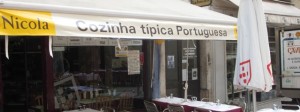Although I’ve hiked all over the world, on occasion for weeks at a time, I’ve never been much of a climber, a fall off a cliff when I was a child probably having something to do with it. In fact, as much as I’ve done in one go may have been New Hampshire’s Mount Monadnock, which when I lived in Boston I climbed once a year to test my general level of fitness by how long it took me to reach the top, and remained entirely unembarrassed that someone had once summited in a snow mobile. Except for a few cultural references, nothing about the story that follows has changed from when I wrote it in 1991. Nor has Mount Monadnock changed much, either. The only difference is my inability to remember where it was published. The Boston Globe, possibly, or Outside magazine. Anybody?
At 3,165 feet, Mount Monadnock, in the southwest corner of New Hampshire, is not exactly the Mount Everest of America. In fact, it’s not even the Mount Everest of New Hampshire. Dozens of peaks in that state are higher. And its balding dome is so easily accessibly by just about all but the bed-ridden that an estimated 125,000 people a year scale it, earning it the dubious distinction of being the most climbed mountain in America. But to ignore Monadnock in favor of more lofty, less democratic, peaks is as serious an omission as to claim an understanding of the performing arts in America without being able to describe a favorite scene from the Jackass reality series.
Climb any of the peaks in New Hampshire’s justly famous White Mountains and what you can see, for the most part, are other peaks. Climb Mount Monadnock, which stands isolated like a naughty boy in the corner of a schoolroom, and what you can see is just about all of New England. That’s partly why it’s listed in the National Register of Natural Landmarks. And that’s partly why it’s always gotten such good press, even from such literary heavies as Thoreau and Emerson, who promoted it almost as enthusiastically as that little green lizard promotes Geico.
Because downtown Boston is only about 60 miles away, and because no camping is allowed on the mountain except at the state park campground at its base, climbing Monadnock is for most people a day trip. You can climb one of the major trails to the summit, claim you can see everything from the Hancock Tower in Boston to the pyramids in Egypt, then climb down the same way you came up. It takes a couple of hours. And if you are like a lot of other people, the chief joy you’ll get out of it, other than the view, is the descent, which on a pleasant Saturday or Sunday in the spring or fall can give you several thousand opportunities to answer condescendingly when asked by the huffing masses still on the way up how much farther it is to the top.
To turn Monadnock into a climbing adventure, give it the weekend it deserves. Drive up early in the morning from Boston or spend the night at one of the Monadnock Region’s campgrounds or country inns. Hike up Monadnock’s wooded slopes to its bare-rock summit, then down the other side to another campground or inn. The next day, hike your way back, following the network of little-used secondary and connecting trails. Along that route you will still occasionally see other hikers off in the distance, streaming along the main trails like ants after sugar. But about the only ones you’ll come face to face with are the few fellow seekers of the road less taken, and the few (slightly more numerous than the former group) who are lost. In the case of those who are lost, you can experience the enormous pleasure of becoming a hero simply by sending somebody in a direction you yourself don’t intend to go.
You can climb Mount Monadnock any time of the year. But even during the most popular times, spring and fall, you’ve got to keep an eye on the weather. Storms can make up quickly, and the dangers of exposure, especially on the bare rock of the summit, are real. Come prepared to dress like Santa.
Monadnock is certainly not Everest. It doesn’t allow you the experiences that belong only to the mountain climbing elite — fighting altitude sickness, dangling by your pitons above eternity, and posing for gear ads. But its a pretty good bet that few superstars of climbing, while standing at a mountain’s summit, have ever brought joy to a trio of ill-prepared but not unattractive young ladies simply by offering them the gift of bottled water.






